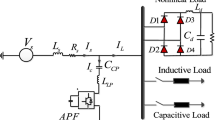Abstract
In this paper, a generalized compensation method of reactive power applicable to a multi-line system under non-sinusoidal conditions is studied. The compensation is confined to parallel compensation with passive components, i.e., inductors and capacitors. If the required reactive currents containing harmonics are given, an L–C network, composed of passive components and generating the required reactive currents, is synthesized. The proposed L–C network is composed of a star-connected part and a circular connected part. It is shown that the proposed method is comprehensive, easy, and systematic to apply.










Similar content being viewed by others
References
Lyon WV (1920) Reactive power and unbalanced circuits. Electrical World 75(25):1417–1420
Fryze S (1932) Active, reactive and apparent power in circuit with sinusoidal voltage and current. Electrotechnische Zeitschrift 53(25):596–599
Miller TJE (1982) Reactive power control in electric systems. Wiley, New York
Enslin JHR, van Wyk JD (1988) Measurement and compensation of fictitious power under nonsinusoidal voltage and current conditions. IEEE Trans Instr Meas 37(3):403–408
Depenbrock M (1993) The FBD-method, a generally applicable tool for analyzing power relations. IEEE Trans Power Systems 8(2):381–387
Mayordomo JG, Usaola J (1993) Apparent power and power factor definitions for polyphase non-linear loads when supply conductors present different resistances. Eur Trans Electr Power 3(6):415–420
Sasdelli R, Montanari GC (1994) Compensable power for electrical systems in nonsinusoidal conditions. IEEE Trans Instr Meas 43(4):592–598
Superti Furga G (1994) Searching for a generalization of the reactive power-a proposal. Eur Trans Electr Power 4(5):411–420
Ferrero A (1998) Definitions of electrical quantities commonly used in nonsinusoidal conditions. Eur Trans Electr Power 8(4):235–240
Singh B, Al-Haddad K, Chandra A (1999) A review of active filters for power quality improvement. IEEE Trans Ind Electron 46(5):960–971
Herrera RS, Salmerón P, Kim H (2008) Instantaneous reactive power theory applied to active power filter compensation: different approaches, assessment, and experimental results. IEEE Trans Ind Electron 55(1):184–196
Singh B, Jayaprakash P, Kothari DP (2015) Comprehensive study of DSTATCOM configurations. IEEE Trans Indus Inform 10(2):854–870
Wang H, Liu S (2019) An optimal operation strategy for an active power filter using cascaded H-bridges in delta-connection. Electr Power Syst Res 1(175):1–12
Shepherd W, Zakikhani P (1972) Suggested definition of reactive power for nonsinusoidal systems. IEE Proc 119(9):1361–1362
Sharon D (1973) Reactive power definition and power-factor improvement in nonlinear systems. IEE Proc 120(6):704–706
Kuster NL, Moore WJM (1980) On the definition of reactive power under non-sinusoidal conditions. IEEE Trans Power Appar Syst 99(5):1845–1854
Aziz MMA, El-Zahab EEA, Ibrahim AM, Zobaa AF (2004) LC compensator for power factor correction of nonlinear loads. IEEE Trans Power Deliv 19(1):331–335
Sharon D (1996) Power factor definitions and power transfer quality in nonsinusoidal situations. IEEE Trans Instr Meas 45(3):728–733
Czarnecki LS (1997) Minimization of reactive power under nonsinusoidal conditions. IEEE Trans Instr Meas 36(1):18–22
Diwan SP, Inamdar HP, Vaidya AP (2011) Simulation Studies of Shunt Passive Harmonic Filters: Six Pulse Rectifier Load-Power Factor Improvement and Harmonic Control. Int J Electr Power Eng 2(1):1–6
Jeon S-J (2017) Passive series-parallel compensator for non-sinusoidal power system. RE&PQJ 1(15):933–938
Jordi O, Sainz L, Chindris M (2002) Steinmetz system design under unbalanced conditions. Eur Trans Electr Power 12(4):283–290
Jeon S-J, Willems JL (2011) Reactive power compensation in a multi-line system under sinusoidal unbalanced conditions. Int J Circ Theor Appl 39(3):211–224
Czarnecki LS (2015) Unbalanced power in four-wire systems and its reactive compensation. IEEE Trans Power Deliv 30(1):53–63
Pană A, Băloi A, Molnar-Matei F (2020) New method for calculating the susceptances of a balancing capacitive compensator for a three-phase four-wire distribution network. Electr Power Energy Syst 115:1–16
LaWhite N, Ilic MD (1997) Vector space decomposition of reactive power for periodic nonsinusoidal signals. IEEE Trans Circuits Syst 44(4):338–346
Jeon S-J (2005) Definitions of apparent power and power factor in a power system having transmission lines with unequal resistances. IEEE Trans Power Deliv 20(3):1806–1811
Spath H (2007) A general purpose definition of active current and non-active power based on German standard DIN 40110. Electr Eng 89(3):167–175
Jeon S-J (2006) Considerations on a reactive power concept in a multi-line system. IEEE Trans Power Deliv 21(2):551–559
Willems JL (1993) Current compensation in three-phase power system. Eur Trans Electr Power 3(1):61–66
Lsee S-Y, Wu C-J (1993) On-line reactive power compensation schemes for unbalanced three phase four wire distribution feeders. IEEE Trans Power Deliv 8(4):1958–1965
Acknowledgements
This work was supported by the Pukyong National University Research Fund in 2016.
Author information
Authors and Affiliations
Corresponding author
Additional information
Publisher's Note
Springer Nature remains neutral with regard to jurisdictional claims in published maps and institutional affiliations.
Rights and permissions
About this article
Cite this article
Jeon, SJ. Passive-component-based reactive power compensation in a non-sinusoidal multi-line system. Electr Eng 102, 1567–1577 (2020). https://doi.org/10.1007/s00202-020-00979-8
Received:
Accepted:
Published:
Issue Date:
DOI: https://doi.org/10.1007/s00202-020-00979-8




